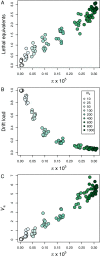The crucial role of genome-wide genetic variation in conservation
- PMID: 34772759
- PMCID: PMC8640931
- DOI: 10.1073/pnas.2104642118
The crucial role of genome-wide genetic variation in conservation
Abstract
The unprecedented rate of extinction calls for efficient use of genetics to help conserve biodiversity. Several recent genomic and simulation-based studies have argued that the field of conservation biology has placed too much focus on conserving genome-wide genetic variation, and that the field should instead focus on managing the subset of functional genetic variation that is thought to affect fitness. Here, we critically evaluate the feasibility and likely benefits of this approach in conservation. We find that population genetics theory and empirical results show that conserving genome-wide genetic variation is generally the best approach to prevent inbreeding depression and loss of adaptive potential from driving populations toward extinction. Focusing conservation efforts on presumably functional genetic variation will only be feasible occasionally, often misleading, and counterproductive when prioritized over genome-wide genetic variation. Given the increasing rate of habitat loss and other environmental changes, failure to recognize the detrimental effects of lost genome-wide genetic variation on long-term population viability will only worsen the biodiversity crisis.
Keywords: extinction; genomics; population dynamics.
Conflict of interest statement
The authors declare no competing interest.
Figures



References
-
- Lande R., Shannon S., The role of genetic variation in adaptation and population persistence in a changing environment. Evolution 50, 434–437 (1996). - PubMed
-
- Saccheri I., et al. , Inbreeding and extinction in a butterfly metapopulation. Nature 392, 491–494 (1998).
-
- Bozzuto C., Biebach I., Muff S., Ives A. R., Keller L. F., Inbreeding reduces long-term growth of Alpine ibex populations. Nat. Ecol. Evol. 3, 1359–1364 (2019). - PubMed
-
- Frankel O., Soulé M. E., Conservation and Evolution (CUP Archive, 1981).
-
- Soulé M. E., Viable Populations for Conservation (Cambridge University Press, 1987).
Publication types
MeSH terms
Grants and funding
LinkOut - more resources
Full Text Sources

